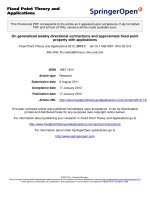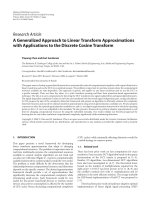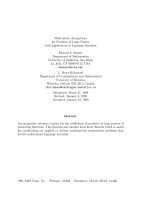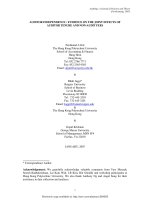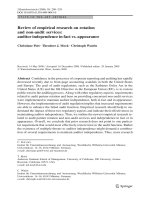Multivariate linear and non linear causality tests with applications
Bạn đang xem bản rút gọn của tài liệu. Xem và tải ngay bản đầy đủ của tài liệu tại đây (715.7 KB, 61 trang )
Multivariate Linear and Nonlinear Causality
Tests with Applications
ZHANG BINGZHI
(B.Sc. Univ. of Science and Technology of
China)
A THESIS SUBMITTED
FOR THE DEGREE OF MASTER OF SCIENCE
DEPARTMENT OF STATISTICS AND APPLIED PROBABILITY
NATIONAL UNIVERSITY OF SINGAPORE
2009
i
Acknowledgements
First and foremost, I would like to take this opportunity to express my earnest
gratitude to my two supervisors Professor Bai Zhidong and Professor Wong Wing
Keung. I have learned a lot from them for both doing research and character
building. They have been giving me many inspiring thoughts and led me to the right
direction to conduct research. When I encounter any problem, I can always receive
timely and patient guidance and advice from them. I would also like to express
my sincere appreciation to the other professors, including Associate Professor Chen
Zehua, Associate Professor Zhang Jin Ting, Assistant Professor Chakrobty Biman,
for their teaching and assistance in my study.
In addition, I wish to contribute the completion of this thesis to my dearest
families, who have always been supporting me with their encouragement and understanding. Special thanks are also given to all the staffs in my department and
all my friends, who have one way or another contributed to my thesis, for their
concern and inspiration in the two years. Finally, I would like to express my heartfelt thanks to the Graduate Programme Committee of the Department of Statistics
ii
and Applied Probability.
iii
Contents
Acknowledgements
i
Summary
v
List of Tables
vi
List of Figures
vii
1 Introduction
1
2 Bivariate Granger Causality Test
6
2.1
Bivariate Linear Granger Causality Test . . . . . . . . . . . . . . .
6
2.2
Bivariate Nonlinear Causality Test . . . . . . . . . . . . . . . . . .
8
3 Multivariate Granger Causality Test
3.1
Multivariate Linear Granger Causality Test . . . . . . . . . . . . .
3.1.1
Vector Autoregressive Regression . . . . . . . . . . . . . . .
13
13
13
iv
3.1.2
3.2
Multiple Linear Granger Causality Hypothesis and Likelihood Ratio Test . . . . . . . . . . . . . . . . . . . . . . . . .
15
Multivariate Nonlinear Causality Test . . . . . . . . . . . . . . . . .
20
3.2.1
Multivariate Nonlinear Causality Hypothesis . . . . . . . . .
20
3.2.2
Test Statistic and Its Asymptotic Distribution . . . . . . . .
21
3.2.3
A Consistent Estimator of Variance of the Test Statistic . .
28
4 Applying the Test to the Segmented Chinese Stock Markets
31
4.1
Description of the Data Set . . . . . . . . . . . . . . . . . . . . . .
31
4.2
Methodology . . . . . . . . . . . . . . . . . . . . . . . . . . . . . .
37
4.2.1
Methodology for Multiple Linear Causality Test . . . . . . .
37
4.2.2
Methodology for Multiple Nonlinear Causality Test . . . . .
39
4.3
The Testing Results . . . . . . . . . . . . . . . . . . . . . . . . . . .
40
4.4
Comparison with the Results of Bivariate
4.5
Granger Causality Tests . . . . . . . . . . . . . . . . . . . . . . . .
46
Conclusion and Further Work . . . . . . . . . . . . . . . . . . . . .
48
Bibliography
49
v
Summary
The traditional linear Granger test has been widely used to examine the linear
causality between any pair of time series. Hiemstra and Jones (1994) developed
a nonlinear Granger causality test to investigate the nonlinear causality between
stock prices and trading volume. In this thesis, we extend their work by developing
both linear and non-linear causality tests in multivariate settings instead of in
pairwise context. We then apply the tests to identify the linear and non-linear
multivariate causality relationships among the indices of the Chinese segmented
stock markets.
Key Words: linear Granger causality, nonlinear Granger causality, U-statistics,
Stock market segmentation
vi
List of Tables
4.1
The list of descriptive statistics for the daily returns of 5 shares . . . . .
36
4.2
Multiple linear testing results for sub-sample1 : 6 Oct.1992-16 Feb. 2001
40
4.3
Multiple nonlinear testing results for sub-sample1 : 6 Oct.1992-16 Feb.
2001 Part I . . . . . . . . . . . . . . . . . . . . . . . . . . . . . . .
41
Multiple nonlinear testing results for sub-sample1 : 6 Oct.1992-16 Feb.
2001 Part II . . . . . . . . . . . . . . . . . . . . . . . . . . . . . . .
42
4.4
4.5
Multiple linear testing results for sub-sample2 : 19 Feb. 2001-31 Dec. 2007 43
4.6
Multiple nonlinear testing results for sub-sample2 : 19 Feb. 2001-31 Dec.
2007 Part I . . . . . . . . . . . . . . . . . . . . . . . . . . . . . . .
44
Multiple nonlinear testing results for sub-sample2 : 19 Feb. 2001-31 Dec.
2007 Part II . . . . . . . . . . . . . . . . . . . . . . . . . . . . . . .
45
Multiple nonlinear testing results for sample : 19 Feb. 2001-30 Dec. 2005
47
4.7
4.8
vii
List of Figures
3.1
Linear causality test results
. . . . . . . . . . . . . . . . . . . . . . .
19
4.1
Daily returns of H shares before and after the policy change on Feb 16th,
2001 . . . . . . . . . . . . . . . . . . . . . . . . . . . . . . . . . . .
34
Daily returns of Shanghai A shares before and after the policy change on
Feb 16th, 2001 . . . . . . . . . . . . . . . . . . . . . . . . . . . . . .
34
Daily returns of Shanghai B shares before and after the policy change on
Feb 16th, 2001 . . . . . . . . . . . . . . . . . . . . . . . . . . . . . .
35
Daily returns of Shenzhen A shares before and after the policy change on
Feb 16th, 2001 . . . . . . . . . . . . . . . . . . . . . . . . . . . . . .
35
Daily returns of Shenzhen B shares before and after the policy change on
Feb 16th, 2001 . . . . . . . . . . . . . . . . . . . . . . . . . . . . . .
36
Bivariate linear and nonlinear causality test results . . . . . . . . . . .
47
4.2
4.3
4.4
4.5
4.6
1
Chapter 1
Introduction
Linear Ganger causality test can be used to detect the causal relation between
two time series; that is, to examine whether past information of one series could
contribute to the prediction of another series. In other words, Granger causality test
examines whether lag terms of one variable significantly explain another variable
in a 2-equation vector autoregressive regression model. The concept of causality
is different from the concept of correlation in two ways. Firstly, causality is the
influence of past values of one variable on the present value of the other, while the
correlation is relation between two variables at the same time. Secondly, correlation
is symmetric with respect to two variables involved, while causal relation is not
symmetric. One variable may not be the reason and result of the other variable at
the same time.
However, the linear Granger causality test does not perform well in detecting
nonlinear causal relationships. To circumvent this limitation, Baek and Brock
2
(1992) developed a nonlinear Granger causality test to examine the remaining
nonlinear predictive power of a residual series of a variable on the residual of another
variable obtaining from a linear model. Hiemstra and Jones (1994) has further
modified the test which we will use to examine the bivariate Granger causality
relationship in my thesis. One series {Yt } that does not strictly Granger cause
another series {Xt } non-linearly is defined as:
L
L
Pr
Xtm − Xsm < e
y
y
Lx
Lx
Xt−L
− Xs−L
< e, Yt−L
− Ys−L
x
y
y
=P r
Xtm − Xsm < e
Lx
Lx
Xt−L
− Xs−L
x
where P r(· | · ) denotes conditional probability and
·
denotes the maximum
norm. The left hand side of the equation is the conditional probability that the
distance between any two m-length lead vectors of {Xt } is less than e, given that
the corresponding Lx -length lag vectors of {Xt } and Ly -length lag vectors of {Yt }
are within distance e. And the right hand side of the equation is the conditional
probability that the distance between any two m-length lead vectors of {Xt } is less
than e, given that only the corresponding Lx -length lag vectors of {Xt } is within
distance e. A more detailed definition will be given in the next chapter. However,
there is a disadvantage of the Hiemstra-Jones test. Diks and Panchenko (2005)
point out that Hiemstra-Jones test might have an over-rejection bias on the null
hypothesis of Granger non-causality. Their simulation results show that rejection
probability will goes to one as the sample size increases. Diks and Panchenko
(2006) address this problem by replacing the global test by an average of local
3
conditional dependence measures. Their new test shows weaker evidence for volume
causing returns than Hiemstra-Jones test does. Besides Hiemstra-Jones test, other
forms of nonlinear causality test has also been developed. For example, Marinazzo,
Pellicoro, and Stramaglia (2008) adopt theory of reproducing kernel Hilber spaces
to develop nonlinear Granger causality test. And Diks and DeGoede (2001) develop
an information theoretic test statistics for Granger causality. They use bootstrap
methods instead of asymptotic distribution to calculate the significance of the test
statistics.
Many studies have adopted Granger causality test to analyze the causal relation
between two series. For example, most of the studies in various stock markets
applied Granger causality test to analyze the causal relation between two stock
markets. However, most of the studies are focused on the bivariate case: exploring
the relation between one series and another. Nevertheless, the multivariate causal
relationship are important but it has not been well-studied. There may exist a
causality relationship from a group of variables to another group of variables, while
we take an arbitrary variable from each group and no causality relationship is found
within any pair of variables chosen like this. In this situation, it is important to
extend the Granger causality test to the multivariate settings to find out whether
this relationship exist.
In Chapter 3, we extend both the linear and nonlinear Granger causality tests
to the multivariate settings. First, for any n variables involved in the causality test,
4
we simply construct a n-equation vector autoregressive regression (VAR) model to
conduct the linear Granger test, and test for the significance of relevant coefficients
across equations using likelihood ratio test. If those coefficients are significantly
different from zero, than the causality relationship is identified.
Thereafter, we will conduct the nonlinear Granger test on the system. We
notice that the bivariate nonlinear Granger test is developed by mainly applying the
properties of U-statistic developed by Denker and Keller (1983, 1986). Central limit
theorem can be applied to the U-statistic whose arguments are strictly stationary,
weakly dependent and satisfy mixing conditions of Denker and Keller (1983, 1986).
When we extend the test to the multivariate settings, we find that the properties
of the U-statistic for the bivariate settings could be used in the development of
our proposed test statistic in the multivariate settings, which is also a function of
U-statistic. Detailed proofs will be given.
In Chapter 4, we demonstrate the applicability of our proposed tests by illustrating them to examine the relationshps among the stock indices in the segmented
Chinese stock markets. There are five return series: H shares in Hong Kong Stock
Exchange and A and B shares listed on the Shanghai Stock Exchange and Shenzhen Stock Exchange. Several studies have been carried out to explore the lead-lag
relations among these indices. For example, Qiao, Li and Wong (2008) studied
the bivariate linear and nonlinear Granger causality relationships among these five
return series from January 1, 1996 to February 16, 2001. One of the limitations
5
of these studies is that they could not examine the multivariate linear and nonlinear causal relationships among these series. To circumvent this limitation, in
this paper we apply the our proposed test statistics to examine these multivariate
relationships. In addition, our study covers more recent data with longer period
from October 6, 1992 to December 31, 2007. A comparison of our findings with
those from the bivariate tests will be made at the last.
6
Chapter 2
Bivariate Granger Causality Test
In this chapter we will review the definitions of linear and nonlinear causality and
discuss the relevant existing tests to identify these causality relationship between
two variables.
2.1
Bivariate Linear Granger Causality Test
First, we introduce the linear Granger causality as follows:
Definition 1. In a two-equation model:
p
p
αi xt−i +
x t = a1 +
i=1
i=1
p
p
βi yt−i + ε1t
(1a)
δi yt−i + ε2t
(1b)
and
y t = a2 +
γi xt−i +
i=1
i=1
7
where all {xt } and {yt } are stationary variables, ε1t , ε2t are the disturbances satisfying the regularity assumptions of the classical linear normal regression model,
and p is the optimal lag in the system. {yt } is said not Granger causing {xt }
if βi = 0 in (1a), for any i = 1, · · · , p. In other words, the past values of {yt } do
not provide any additional information on the performance of {xt }. Similarly, {xt }
does not Granger Cause {yt } if γi = 0 in (1b), for any i = 1, · · · , p.
Now, we can test for causal relations between {xt } and {yt } by testing the
following null hypotheses separately:
H01 : β1 = · · · = βp = 0, and
H02 : γ1 = · · · = γp = 0.
From testing these hypotheses, we have four theoretically possible test results:
(1) If both Hypotheses H01 and H02 are accepted, there is no linear causal relation
between {xt } and {yt }.
(2) If Hypothesis H01 is accepted but Hypothesis H02 is rejected, then linear causality runs unidirectional from {xt } to {yt } .
(3) If Hypothesis H01 is rejected but Hypothesis H02 is accepted, then linear causality runs unidirectional from {yt } and {xt } .
(4) If both Hypotheses H01 and H02 are rejected, there exist feedback linear causal
relationships between {xt } and {yt }.
8
To test either of the hypotheses, one could use the standard F-test. To test the
hypothesis β1 = · · · = βp = 0 in (1a), the sum of squares of the residuals from both
the full regression, SSEF , and the restricted regression, SSER , are computed in
the equation (1a) and the following F test
F =
(SSRR − SSRF )/p
SSRF /(n − 2p − 1)
(2.1)
can be computed where p is the optimal number of lag terms of yt in the regression
equation on xt , and n is the number of observations. If {yt } does not Granger
cause {xt }, F in (2.1) is distributed as F(p,n−2p−1) . For any given significance level
α, we reject the null hypothesis H01 if F exceeds the critical value F(α,p,n−2p−1) .
Similarly, we can test for the second null hypothesis H02 : γ1 = · · · = γp = 0, and
then identify the linear causal relationship from {xt } to {yt }.
2.2
Bivariate Nonlinear Causality Test
The general test for nonlinear Granger causality is first developed by Baek and
Brock (1992) and, later on, modified by Hiemstra and Jones (1994). As the linear
Granger test is inefficient in detecting any nonlinear causal relationship, to examine
the nonlinear Granger causality relationship between a pair of series, say {xt }
and {yt }, one has to first apply the linear models in (1a) and (1b) to {xt } and
{yt } for identifying their linear causal relationships and obtain their corresponding
residuals, {ˆ
ε1t } and {ˆ
ε2t }. Thereafter, one has to apply a non-linear Granger
causality test to the residual series, {ˆ
ε1t } and {ˆ
ε2t }, of the two variables being
9
examined to identify the remaining nonlinear causal relationships between their
residuals.
Now we introduce the definition of nonlinear Granger causality and discuss the
corresponding test developed by Hiemstra and Jones as follows:
Definition 2. For two strictly stationary and weakly dependent residual series
{Xt } and {Yt }, the m-length lead vector of Xt is given by
Xtm ≡ (Xt , Xt+1 , · · · , Xt+m−1 ) , m = 1, 2, · · · , t = 1, 2, · · ·
and Lx -length lag vector of Xt is defined as
Lx
≡ (Xt−Lx , Xt−Lx +1 , · · · , Xt−1 ), Lx = 1, 2, · · · , t = Lx + 1, Lx + 2, · · ·
Xt−L
x
Similarly, Ly length lag vector of Yt are given by
L
y
Yt−L
≡ (Yt−Ly , Yt−Ly +1 · · · , Yt−1 ), Ly = 1, 2, · · · , t = Ly + 1, Ly + 2, · · ·
y
For any given values of m, Lx , and Ly ≥ 1 and for e ≥ 0, series {Yt } does not
strictly Granger cause another series {Xt } non-linearly if and only if:
L
L
Pr
Xtm − Xsm < e
y
y
Lx
Lx
Xt−L
− Xs−L
< e, Yt−L
y
y
x
x
=P r
Xtm − Xsm < e
Lx
Lx
Xt−L
x
x
where P r(· | · ) denotes conditional probability and
·
denotes the maximum
norm: For any vector X = (x1 , · · · , xn ) and Y = (y1 , · · · , yn ),
X − Y = max (|x1 − y1 |, |x2 − y2 |, · · · , |xn − yn |)
10
The test statistic is given by
√
n
C1 (m + Lx , Ly , e, n) C3 (m + Lx , e, n)
−
C2 (Lx , Ly , e, n)
C4 (Lx , e, n)
(2.2)
where
C1 (m + Lx , Ly , e, n) ≡
2
n(n − 1)
L
m+Lx
x
I xm+L
t−Lx , xs−Lx , e
t
y
y
·I yt−L
, ys−L
,e
y
y
C2 (Lx , Ly , e, n) ≡
2
n(n − 1)
L
x
x
,e
, xLs−L
I xLt−L
x
x
t
y
y
·I yt−L
, ys−L
,e
y
y
C3 (m + Lx , e, n) ≡
C4 (Lx , e, n) ≡
2
n(n − 1)
2
n(n − 1)
m+Lx
x
I xm+L
t−Lx , xs−Lx , e
t
x
,e
, xLs−L
I xLt−L
x
x
t
t, s = max(Lx , Ly ) + 1, · · · , T − m + 1, n = T + 1 − m − max(Lx , Ly )
and
0, if x − y > e
I(x, y, e) =
1, if x − y ≤ e
This test statistic has the following property:
Theorem 1. For given values of m, Lx , Ly and e > 0, under the assumptions
that {Xt }, {Yt } are strictly stationary, weakly dependent, and satisfy the conditions
stated in Denker and Keller (1983), if {Yt } does not strictly Granger cause {Xt },
11
then
√
n
C1 (m + Lx , Ly , e, n) C3 (m + Lx , e, n)
−
C2 (Lx , Ly , e, n)
C4 (Lx , e, n)
a
∼ N (0, σ 2 (m, Lx , Ly , e))
a
where ∼ means following the distribution asymptotically, and the estimator of the
variance σ 2 (m, Lx , Ly , e) stated in Hiemstra and Jones (1994) is
ˆT · Σ
ˆ
ˆ ·d
σ
ˆ 2 (m, Lx , Ly , e) = d
where
d =[1/C2 (Lx , Ly , e, n), −C1 (m + Lx , Ly , e, n)/C22 (Lx , Ly , e, n),
− 1/C4 (Lx , e, n), C3 (m + Lx , e, n)/C42 (Lx , e, n)]T
ˆ is a matrix containing elements
and Σ
K(n)
ˆ i,j = 4 ·
Σ
ωk (n)
k=1
1
2(n − k + 1)
K(n) = (int)n1/4 ,
1,
ωk (n) =
2(1 − [(k − 1)/K(n)]),
Aˆi,t (n) · Aˆj,t−k+1 (n) + Aˆi,t−k+1 (n) · Aˆj,t (n)
t
if k = 1,
otherwise,
t = max(Lx , Ly ) + k, · · · , T − m + 1,
n = T + 1 − m − max(Lx , Ly )
,
12
Aˆ1,t =
1
n−1
L
L
y
y
m+Lx
m+Lx
, e) · I(Yt−L
, Ys−L
, e)
I(Xt−L
, Xi,s−L
x
y
y
x
s=t
− C1 (m + Lx , Ly , e, n)
Aˆ2,t =
1
n−1
L
s=t
− C2 (Lx , Ly , e, n)
Aˆ3,t =
1
n−1
m+Lx
m+Lx
I(Xt−L
, Xs−L
, e)
x
x
s=t
− C3 (m + Lx , e, n)
Aˆ4,t =
1
n−1
L
y
y
Lx
Lx
I(Xt−L
, Xs−L
, e) · I(Yt−L
, Ys−L
, e)
x
x
y
y
Lx
Lx
, e)
, Xs−L
I(Xt−L
x
x
s=t
− C4 (Lx , e, n)
t, s = max(Lx , Ly ) + 1, · · · , T − m + 1
13
Chapter 3
Multivariate Granger Causality
Test
3.1
Multivariate Linear Granger Causality Test
3.1.1
Vector Autoregressive Regression
In this section, we will extend the pairwise linear Granger test to the multiple
settings in the Vector Autoregressive Regression (VAR) scheme. For t = 1, · · · , T ,
the n-variable VAR model can be represented as follows:
y1t A10 A11 (L) A12 (L) . . .
y A A (L) A (L) . . .
2t 20 21
22
=
+
. . .
..
.. .. ..
.
ynt
An0
An1 (L) An2 (L) . . .
A1n (L) y1, t−1 e1t
A2n (L) y2, t−1
e2t
. + .
..
. ..
..
Ann (L)
yn, t−1
ent
14
where (y1t , · · · , ynt ) is the n-variable vector stationary time series at time t, L is
the backward operation where L(xt ) = xt−1 , Ai0 are intercept parameters, Aij (L)
are polynomials in the lag operator L:
Aij (L) = aij (1)L + aij (2)L2 + · · · + aij (p)Lp
and et = (e1t , · · · , ent ) is the disturbance vector obeying the assumption of the
classical linear normal regression model.
Generally, each equation in VAR has the same lag length for each variable and
the regressors are identical in all equations. So a uniform order p will be chosen
for all the lag polynomials Aij (L) in the VAR model according to a certain criteria
such as Akaike’s Information Criterion (AIC) or Schwarz Criterion (SC). Along
with the Gauss-Markov assumptions satisfied for the error terms, Ordinary Least
Square (OLS) estimation is appropriate to be used to estimate the model since it is
consistent and efficient. However, long lag length for each variable will consume a
lot of degrees of freedom. As in the model mentioned above, there will be n(np + 1)
coefficients (include the intercept terms), n variances and n(n − 1)/2 covariances
to be estimated. When the sample size available is not large enough, including
too much regressors will make the estimation inefficient and thus cause the test
unreliable. To address this problem, a Near-VAR model might be adopted. In this
model, different regressor is allowed in each equation. And seemingly unrelated
regressions (SUR) is used instead of OSL to estimate the equations simultaneously.
SUR uses generalized least squares to estimate the coefficient. For an m-equation
15
system
Y1 X1 0
Y 0 X
2
2
=
. .
..
.. ..
.
Yn
0
0
0 ···
0 β1 e1
0 ··· 0
β2 e2
+
. .
..
..
. ···
.
.. ..
0 · · · Xn
βn
en
or
Y = Xβ + e
SUR estimator is
βˆ = X t V −1 X
−1
XV −1 Y
where
V = Σ ⊗ IT
where Σ is the covariance matrix of the residuals and ⊗ is the Kronecker product.
In this thesis, we will only use the common VAR model to identify the causality
relationship between vectors of time series.
3.1.2
Multiple Linear Granger Causality Hypothesis and
Likelihood Ratio Test
To test the causality relationship between two stationary vector time series : xt =
(x1,t , · · · , xn1 ,t ) and yt = (y1,t , · · · , yn2 ,t ) , where there are n1 + n2 = n
˜ series in
16
total, we may construct a n-equation VAR in the following:
xt Ax[n1 ×1] Axx (L)[n1 ×n1 ] Axy (L)[n1 ×n2 ] xt−1 ex
=
+
+
yt
Ay[n2 ×1]
Ayx (L)[n2 ×n1 ] Ayy (L)[n2 ×n2 ]
yt−1
ey
where Ax[n1 ×1] and Ay[n2 ×1] are two vectors of intercept terms, and Axx (L)[n1 ×n1 ] ,
Axy (L)[n1 ×n2 ] , Ayx (L)[n2 ×n1 ] and Ayy (L)[n2 ×n2 ] are matrices of lag polynomials.
Similarly as in the bivariate case, there are four situations for the causality
relationship between two vector time series xt and yt :
(1) Unidirectional causality from yt to xt exists if Axy (L) is significantly different
from zero and at the same time Ayx (L) is not significantly different from zero.
(2) Unidirectional causality from xt to yt exists if Ayx (L) is significantly different
from zero and at the same time Axy (L) is not significantly different from zero.
(3) feedback exists when both Axy (L) and Ayx (L) are significantly different from
zero.
(4) independence is rejected when either Axy (L) and Ayx (L) is not significantly
different from zero.
To test the following null hypothesis:
(1) H0 : Axy (L) = 0, or
(2) H0 : Ayx (L) = 0, or
17
(3) H0 : Axy (L) = 0 and Ayx (L) = 0.
We may first run the regression using OLS for each equation without any restrictions on the parameters, and then we obtain the residual covariance matrix Σ.
Secondly, we run the regression with the restriction imposed by the null hypothesis
and obtain the restricted residual covariance matrix Σ0 . Then we got the likelihood
ratio statistics suggested by Sims (1980):
(T − c)( log|Σ0 | − log|Σ| )
where T is the number of usable observations, c is the number of parameters estimated in each equation of the unrestricted system, log|Σ0 | and log|Σ| are the natural logarithm of the determinant of restricted and unrestricted residual covariance
matrix correspondingly. This test statistic has the asymptotic χ2 distribution with
the degree of freedom equal to the number of restrictions on the coefficients in the
system. For example, when we test H0 : Axy (L) = 0, we should let c equal to n
˜ p+1,
and there are are n2 × p restrictions on the coefficients in the first n1 equations in
the model. Hence, the corresponding test statistic (T − (˜
np + 1))( log|Σ0 | − log|Σ| )
asymptotically follows χ2 with the degree of freedom equal to n1 × n2 × p. The
conventional bivariate causality test is an special case of the multivariate causality
test. Besides the F test, the likelihood ratio test introduced in this thesis could be
used to identify the relationship.
We note that one can test a particular causality relationship in more than one
VAR models. For example, let’s consider the causation relation among five return



